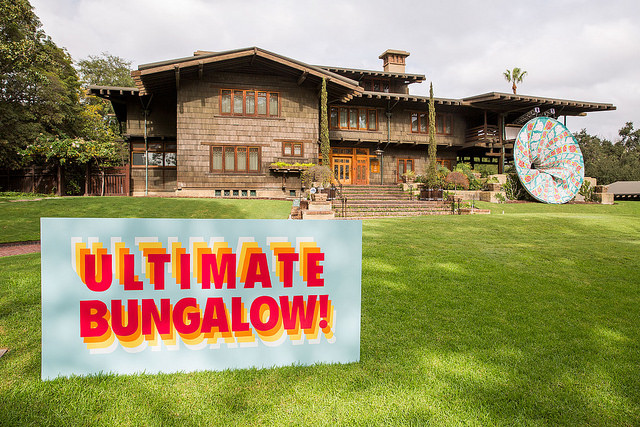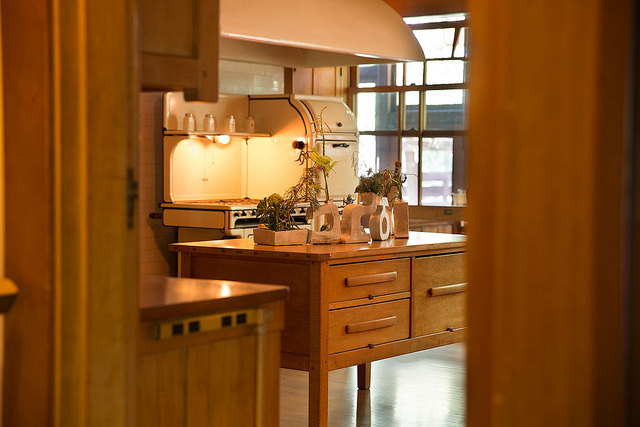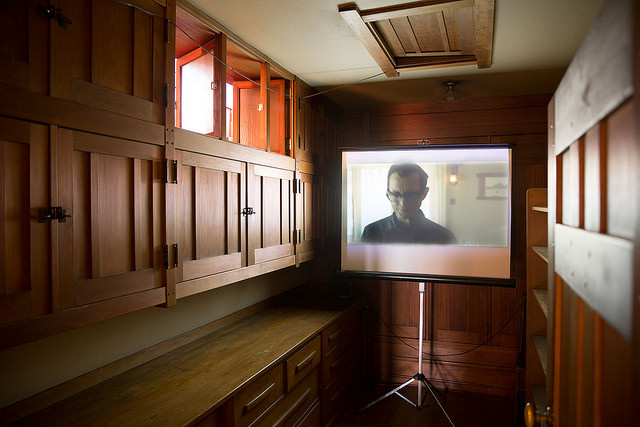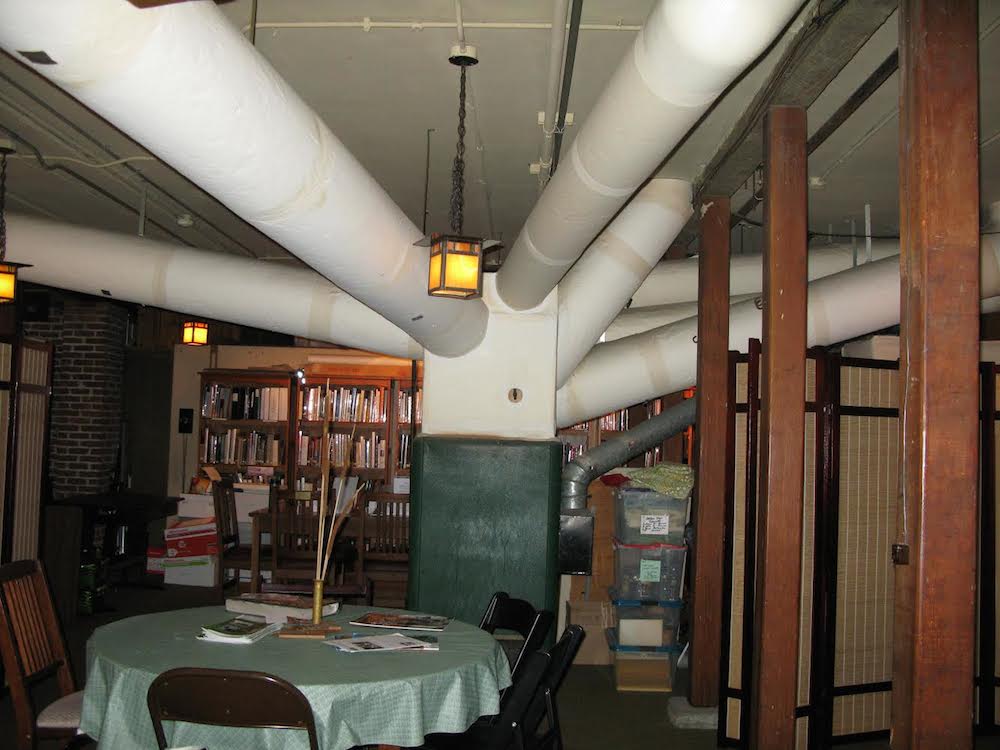On a hot October evening I stood on the front walk of Greene and Greene’s Gamble House in Pasadena and watched a puppet crane poke his beak through the center of what can only be described as an Arts and Crafts vortex. A nearly 30-foot-wide sculpture hung from the street façade, patterned in a hallucinogenic, Morris-style rose motif. The crane and rose are, of course, the Gamble family crest. Its author, artist Patrick Ballard, calls it The Swirling Mess Below the Sleeping Porch Soon Solidified into a Crest of Phantasmagoric Weight that Creaks Between the Doors, the Floors, and a Form that Could Never Be a House Again.

Standing in line to enter the house for a tour of several dozen artworks and performances as part of The Machine Project Field Guide to The Gamble House, the warm night drew close, a preview of the stuffy interior to come. Yet, to complain about the weather in Los Angeles is to, in a word, complain. Fall skies blaze. There’s talk of fires in canyons. The endless heat wave of our Indian summer, the ever-tightening water-use regulations, and the smoggy brown haze at the horizon are all part of living in Arcadia. Still, the draw of the mythic clime tugs at the loose things—a perennial tumbling jumble of pale Midwest and East Coast denizens that land dazed and blinking in the golden afternoon glare.
The West Coast has a long tradition of designing for lifestyle, and it repeats anew in every era, a cliché continually reinforcing itself. Not too long ago a pair of New York transplants opened up a vegan, raw, yoga-friendly wellness center, restaurant, and wine bar in a former paper warehouse located in Los Angeles’ no-longer-particularly industrial Arts District. In 13,000 square feet, the architects, Design, Bitches, captured the wellness zeitgeist in stock materials: polished concrete, stained plywood, and CMU block. The apt name of this Edenic lifestyle emporium: The Springs. It is Arcadia in a warehouse.
The Springs, however, is the latest local manifestation of a holistic urge enacted in both daily ritual and material culture. A century ago, Pasadena’s Arroyo Culture embodied the precepts of Craftsman living. The Gamble House is the best-preserved and most fully detailed example of Gustav Stickley’s persuasive tracts. Just as today’s seekers of health, happiness, and better living turn to ritualized practice and aesthetics, drinking green juices and purchasing organic yoga pants, Stickley’s magazine translated the Arts and Crafts Movement into a consumable practice. Think of it as Real Simple meets Apartamento for the 1900 set. His intoxicating combination of Ruskin aphorisms and back-to-the-land instructions (akin to today’s artisanal entrepreneurship best epitomized—and satirized—in a mason jar of Brooklyn-cured pickles) were interpreted by Craftsman masters Henry and Charles Greene and their master builder Peter Hall into a series of elaborate residences around Pasadena’s Orange Grove Boulevard, otherwise known as Millionaire’s Row.
Progressive industrialist families—like Chicago’s Gambles of Procter & Gamble and the Wrigleys of Wrigley Chewing Gum—flocked to Pasadena seasonally to escape easterly chills. Along with a temperate climate, the California Craftsman scene offered expansive freedoms, some architectural—with the bungalow’s indoor-outdoor allure—and some cultural—the loosening of society’s strictures. In her introduction to the exhibition catalog California Design 1900, curator Eudorah M. Moore cites the relationship between the natural world and both personal connection to the western landscape.
“The benign climate brought an almost romantic consciousness of nature,” she writes. “There was a sense of timelessness of being in a world apart—a world which could be remade in one’s one vision—in which one’s desired life style could be realize and one’s influence felt.” She goes on to take the freedom afforded by the natural world a step further into alternative territories, she tracks the rise of yogi influences, the Theosophical communities, and even the rise of an environmental movement at the time. “That the qualities of shimmering light, benevolent climate and room to grow, along with a profound awareness of the beauties of nature, affected the creative output of artist and architect alike there can be no doubt. The ideational climate of the State at this period was as permissive as the weather, though the appearance of exotic colonies in complacent middle class communities caused ripples…. There was scarcely a religious attitude which was not represented in the State.”1
Every inch of the gesamtkunstwerk Gamble House, from the Alpine-style front porch, to carved reliefs of Mount Fuji, to the plush rugs, shows the touch of a maker’s hand. The interior is a celebration of labor at its most creative and bespoke. It’s no wonder the project is cited as the beginning of the Greenes’ high period: the ultimate bungalow.
In his extensive introduction to the 1976 book Greene & Greene: Architecture as a Fine Art, critic and L.A. enthusiast Reyner Banham reframes the architectural narrative of the Arts and Crafts period, which considers architects such as the Greenes, C.F.A. Voysey, and Charles Rennie Mackintosh pioneers (his italics, following Nikolaus Pevsner) of Modern Architecture (his capitalization). In his assessment of historical importance, the particularity and unclassifiable nature of their designs trumps any general allegiance within the formal canon. Perhaps Banham’s alliance with the quotidian came from his intimate knowledge of the Gamble House. In the same introduction he notes that he lived within its mahogany walls for varying stays over eight years from the late 1960s through the ’70s. And from that comfortable seat he offers a critique of the socio-political atmosphere:
The International Arts and Crafts Villa Movement—to which the works of the brothers Greene irresistibly belong—was the last, brief and almost perfect flowering of that striving bourgeois ethic of plan living and high thinking that had contributed so much to the life of the Victorian epoch, whose members had now discovered how to live high as well as think high by the neat compromise of buying luxurious comfort that could be excused as art. What’s more—socially responsible art!2
The inherent unease of what today we might call “high social” meets “high aesthetic” was played this fall as the Los Angeles-based art collective Machine Project took up residency in Greene & Greene’s ultimate bungalow as part of Pasadena’s two-week AxS Curiosity Festival. The Machine Project Field Guide to The Gamble House included an exhaustive set of activities and artworks that, to quote the group’s press materials “brings the Arts and Crafts movement in parallel with today’s Maker groups”: experimental tours, performances, group naps, séances, cat-house and soapmaking workshops, and a Swiss-Japanese fusion pop-up restaurant.
Machine Project’s project operates both as a catalyst for contemporary art making, often with a social practice agenda, and as counterpoint to Los Angeles’ booming art market. Machine holds these two positions simultaneously, with a gallery and event space in an Echo Park storefront and a growing roster of institutional collaborations. It’s a generative dialectic that fosters young makers, artist, and thinkers in art experiments and allows some of L.A.’s highest profile artists to cross between positions as figures on the scene that represent, via Banham, both the high social and high aesthetic. For example, artist Laura Owens exhibited a painting in the second floor hall. An abstract painter specializing in oversized canvases thick with acrylic and collage-like imagery, she shares studio space with the gallery 365 S. Mission Road in a 12,000-square-foot industrial building in Boyle Heights, just across the Los Angeles River from The Springs. The space is affiliated with New York’s Gavin Brown Enterprise and home to the funky zine and art bookshop Ooga Booga as well as weekly mindfulness meditation classes. It also catalyzed a boom in arts development in the area, aka the birth of the supersized L.A. gallery.
Mark Allen, Machine Project’s founder and director, posits the group occupation of the Gamble House as a rejection of the contemporary art world’s art fair mentality. “When the constraint is the market, you make work for the market,” Allen notes. He’s not interested in what he describes as “a frictionless, context-less place for art.” Instead, he works collaboratively with artists, who are asked to leave their egos at the door.
Field Guide programs changed from day to day, including off-kilter enactments and domestic scale insertions into the life of the house. Artworks included sculptural vases to hold the Gamble House Flower Committee’s arrangements or new prints and paintings hung in the place of originals. On the night of the tour I attended, dancers who wore Masonic masks and costumes moved silently through the throngs of people crowded in the foyer, landing, and upstairs hall. A previous evening, artist Sasha Archibald staged a series titled Bed Conversations. Two pajama-clad, self-defined intellectuals would climb into each of the twin beds in the downstairs guest bedroom for “bedtime chatter.”

A concept behind The Swirling Mess Below the Sleeping Porch Soon Solidified into a Crest of Phantasmagoric Weight that Creaks Between the Doors, the Floors, and a Form that Could Never Be a House Again, like other pieces in the exhibition, is to create a link between contemporary practices and the Craftsman era. Allen calls the vortex piece the “unconscious of the house,” but perhaps the beautifully shot film by David Fenster screened in the upstairs linen closet gets closer to the conflicting identities—the ids and egos—embedded in the Gamble House. Performance artist and playwright Asher Hartman leads the camera through a psychic reading. He senses the wood panels expanding, a child playing, acorns in the earth, laborers, and a tribe of people dressed in white. “This is a house that very much wants to feel itself,” intones Hartman. “These are very old energies that are here and they are rising in skeletal form.”

The culture, the architecture, and the environment of 1908, the year the house was built, over and over is juxtaposed with contemporary practice. Few works account for the century in-between. Part of this problem is the Gamble House itself. Although members of the Gamble family lived in the house until the mid-1960s, a 2003 restoration and conservation effort froze the residence in time. The rooms and halls are static, as if David or Mary Gamble had just left for a moment. All objects and furnishings date from the Craftsman period, even if not original. In this configuration it is impossible to imagine the woolly Banham living and writing his intimate critique.
There’s a period in the 1970s, however, when the house was neither family estate nor conserved property. In the years leading up to the house’s designation as a California State Historic Landmark (1974) and a National Historic Landmark (1978), it was the center of Pasadena’s Arts and Crafts Revival, a loose collection of historians, architects, and builders. Architect Tim Andersen was part of the circle. He describes Banham as a character hanging around the place and remembers himself as a bit of a Greene & Greene geek obsessed with the architects’ meticulous details.
In 1974 he worked with curator Eudorah M. Moore on the exhibition at the Pasadena Art Museum titled “California Design—1910”. The show not only inaugurated what would become the seminal California Design series, it also documented the Craftsman tradition in the state. The show took a stance in defense of these old houses around Pasadena and elsewhere. Structures that are now so treasured and iconic had gone out of style and were threatened by demolition and the reverberations of modernism in mainstream sensibilities. “We were quoting Ruskin and Stickley and living what we believed the 1910 people aspired to,” recalled Andersen in a phone call from his current home in Seattle. “The 1970s seemed like a reflective decade of the 1910 period. We were dissatisfied with the consumer culture paradigm. People were rediscovering the intentions but not aware of the historical context.”
Andersen worked with Moore and the Pasadena Art Museum on a second exhibition two years later. “Craftsman Lifestyle: The Gentle Revolution” surveyed furniture makers, jewelers, potters, and weavers from the bottom to the top of California. The exhibition catalog, written by Olivia H. Emery, features Andersen’s photographs of bearded and bell-bottomed artisans in their studios and converted garages. The black-and-white images are casual, paired with first-person reflections from the artists. The spreads offer up germane maxims, such as the one on page 118:
One day we shall win back art to our daily labor; win back art, that is to say, the pleasure of life, to the people.
—William Morris3
Unwittingly, The Machine Project Field Guide to The Gamble House is a closer reenactment of this middle period, a piece of the historical record less pronounced in the life of the house. There is one work that makes visible the inner workings of the Gamble House and the more peculiar episode’s history, and does so by following the climate conditioning. After all, the SoCal weather is the ever-ready foil to be both praised and conquered. Rosten Woo’s study of the air conditioning and ventilation systems, produced as a newsprint pamphlet and guide to all works in the exhibition, is willfully indebted to Banham’s 1969 Architecture of the Well-Tempered Environment. Indeed, the cover pays homage to that text’s Op-Art graphics.
Woo begins with passive cooling elements integral to the Greenes’ design: orientation to prevailing window and deep porches for shade and sleeping, a fresh-air room to vent the dank basement, and operable attic windows. We learn that the branching ducts of Gamble House’s furnace gave it the name The Octopus, a mechanical beast that offers up its own logic. Air conditioning was installed in the Gamble House in 1976 and it is here, with the introduction of a controlled climate into bespoke chambers, that Woo’s narrative calls attention to various disjunctures in period detailing. Nonconforming metal vents in the upstairs bedrooms and wooden attic vent covers from 1977 designed by Eugene Kazor, Woo writes, “strike an interesting balance between a modern utilitarian vent design and the Gamble House’s intricate woodwork.”

Incongruous portable fans in nearly every room belie the house’s use as a didactic illustration of natural ventilation (as Banham does in 1969). Each one is its own swirling vortex. Each one is a whirring reminder that when faced with the decision of choosing between “high social” and “high aesthetic,” we really just want to be cool.
-
Timothy J. Anderson and Eudorah M. Moore, California Design—1910 (Santa Barbara: Peregrine Smith, 1974), 12. ↩
-
Reyner Banham, “Introduction,” Greene & Greene by Randell L. Makinson (Salt Lake City: Peregrine Smith, 1977), 12. ↩
-
Olivia H. Emery and Tim Anderson, Craftsman Lifestyle: The Gentle Revolution (Pasadena: California Design Publications, 1977), 118. ↩
Mimi Zeiger is a Los Angeles-based journalist and critic, covering architecture, art, urbanism, and design.

